Lessico
Acetosa
Rumex acetosa
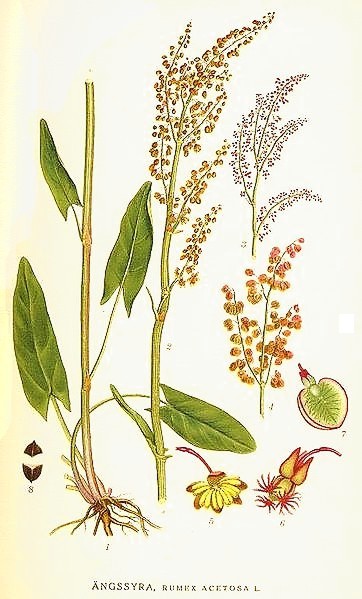
Nome comune sotto cui si raggruppano diverse specie di piante, tutte appartenenti al genere Rumex della famiglia Poligonacee. Si tratta di erbacee perenni, rustiche, spontanee e infestanti, talvolta coltivate a scopo alimentare, accomunate dal fatto di avere le foglie dal sapore acidulo per la presenza di acido ossalico. La specie più nota e diffusa è Rumex acetosa, conosciuta come acetosa maggiore, con fusti alti tra i 50 e i 90 cm, foglie oblungo-astate, fiori molto piccoli, unisessuali, verdastri e rossicci, raccolti in rade pannocchie; il frutto è un achenio. Altre specie simili sono Rumex acetosella, nota come acetosa minore o erba brusca, più piccola della precedente; Rumex alpinus, conosciuto come rabarbaro alpino; Rumex scutatus.
Acetosa
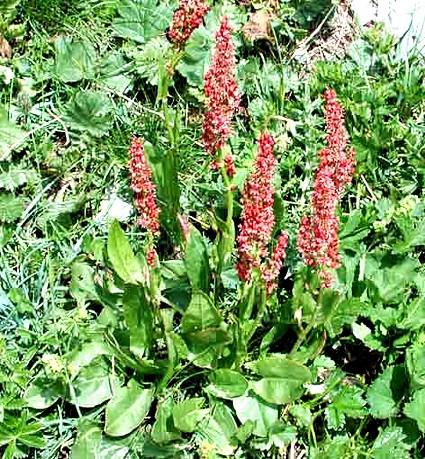
L'acetosa (Rumex acetosa) o erba brusca è una pianta erbacea, perenne, provvista di una grossa radice, dalla quale, in primavera, si sviluppa un fusto eretto, semplice o poco ramificato di colore rossastro, può raggiungere l'altezza di un metro. La pianta contiene Vitamina C, ossalato di ferro, acido ossalico e ferro. Le foglie sono di due tipi: quelle basali formano una rosetta e sono provviste di un lungo picciolo. La forma è del tipo astata. Quelle disposte lungo il fusto sono sessili e non hanno picciolo. I fiori sono distinti in maschili, di colore rossiccio, disposti in fascetti su una piccola pannocchia di forma slanciata. La fioritura inizia a fine primavera e dura tutta l'estate. Il frutto è un achenio ricoperto dai petali, persistenti, che assumono un colore rosso ruggine. È diffusa in tutta Italia, dal mare ai monti, in luoghi aperti e lungo i corsi d'acqua. La pianta si può raccogliere tutto l'anno, anche radendo la piantina in quanto la radice emetterà nuovamente.
Ha proprietà diuretiche, rinfrescanti, antinfiammatorie, essendo ricca di ossalati e di antrachinoni. Discrete proprietà emmenagoghe, stomachiche. Le foglie sono consumate fresche come blando depurativo, oppure si usa un infuso di 30 g di radici per 1 l d'acqua. Viene usata per curare l'acne, le pelli grasse e la puntura di insetti, usando un decotto di 15 g di foglie fresche per 1 l d'acqua, e bevendone due tazze al giorno sempre lontano dai pasti. Con le foglie decotte si prepara un cataplasma utile per curare gli ascessi. Per uso esterno, come pediluvio per favorire la circolazione e il decongestionamento, si prepara un decotto d 50 g per 2 l d'acqua poi uniti all'acqua del pediluvio. Proibita a quanti soffrono di calcoli, artrite, gotta, reumatismi,iperacidità. In caso di elevata ingestione di foglie crude sono stati riscontrati avvelenamenti con lesioni renali in bambini. Incompatibilità con le acque minerali e con i contenitori in rame.
Ha un sapore acidulo e si usa in aggiunta alle insalate fresche, agli spinaci e le verdure cotte in genere. Le foglie possono essere consumate fresche in piccole quantità. Si prepara anche una salsa per accompagnare pesce e carne. La varietà hortensis, che è quella coltivata, contiene meno ossalati.
foto di Marinella Zepigi
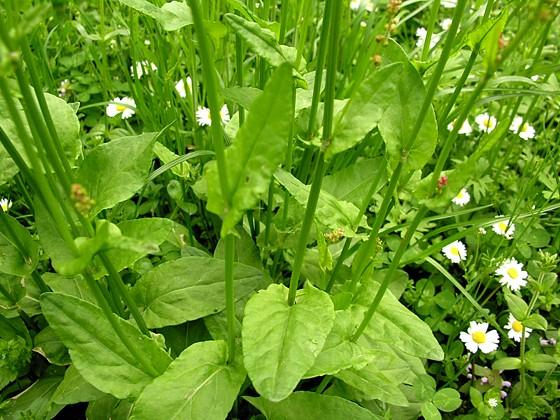
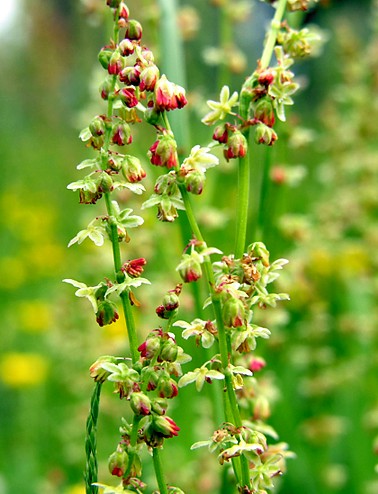
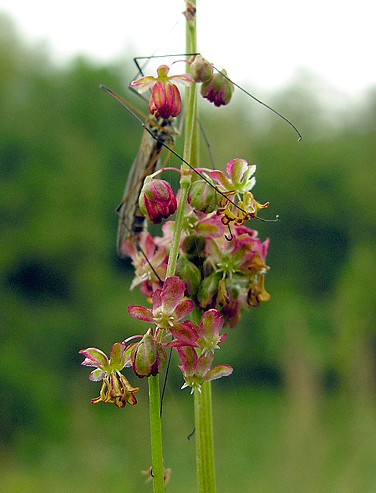
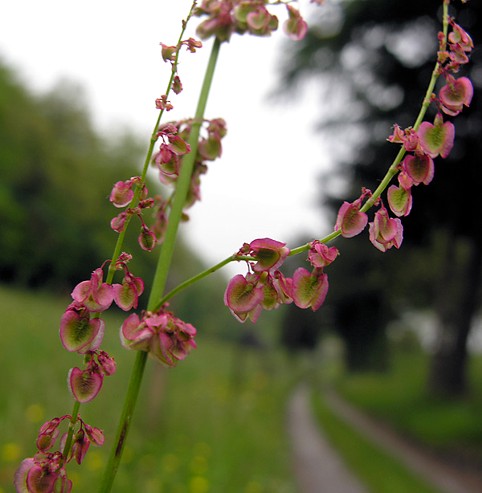
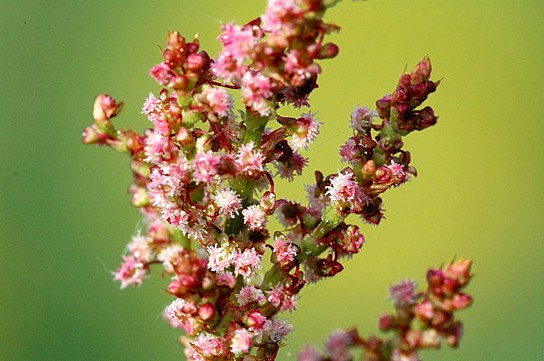
Common Sorrel or Garden Sorrel (Rumex acetosa), often simply called sorrel and also known as Spinach Dock or Narrow-leaved Dock, is a perennial herb that is cultivated as a garden herb or leaf vegetable (pot herb). This is not related to Jamaican sorrel (roselle). Sorrel is a slender plant about 60 cm high, with roots that run deep into the ground, as well as juicy stems and edible, oblong leaves. The lower leaves are 7 to 15 cm in length, slightly arrow-shaped at the base, with very long petioles. The upper ones are sessile, and frequently become crimson. The leaves are eaten by the larvae of several species of Lepidoptera (butterfly and moth) including the Blood-vein moth. It has whorled spikes of reddish-green flowers, which bloom in summer, becoming purplish. The stamens and pistils are on different plants (dioecious); the ripe seeds are brown and shining.
Common sorrel has been cultivated for centuries. The leaves may be puréed in soups and sauces or added to salads and shav; they have a flavor that is similar to kiwifruit or sour wild strawberries. The plant's sharp taste is due to oxalic acid, and so may be contraindicated in people with rheumatic-type complaints, kidney or bladder stones. Sorrel is also a laxative.
Rumex acetosella
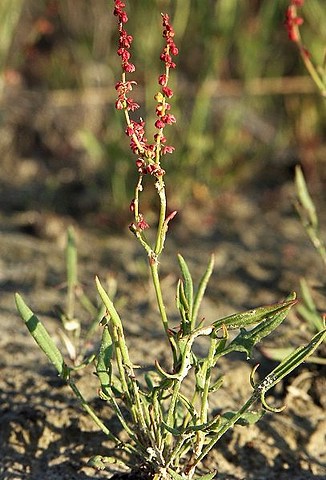
Rumex acetosella is a species of sorrel bearing the common names sheep's sorrel, red sorrel, sour weed, and field sorrel. The plant and its subspecies are common perennial weeds. It has green arrowhead-shaped leaves and red-tinted deeply ridged stems, and it sprouts from an aggressive rhizome. The flowers emerge from a tall, upright stem. Female flowers are maroon in color. The plant is native to Eurasia but has been introduced to most of the rest of the northern hemisphere. In North America it is a common weed in fields, grasslands, and woodlands. It favors moist soil, so it thrives in floodplains and near marshes. It is often one of the first species to take hold in disturbed areas, such as abandoned mining sites, especially if the soil is acidic. Livestock will graze on the plant, but it is not very nutritious and contains oxalates which make the plant toxic if grazed in large amounts. Rumex acetosella is a host plant for Lycaena phlaeas, also known as the American Copper or Small Copper butterfly.
Sheep's sorrel is widely considered to be a noxious weed, and one that is hard to control due to its spreading rhizome. Blueberry farmers are familiar with the weed, due to its ability to thrive in the same conditions under which blueberries are cultivated. It is commonly considered by farmers as an Indicator plant of the need for liming. There are several uses of sheep sorrel in the preparation of food including a garnish, a tart favoring agent and a curdling agent for cheese. The leaves have a lemony, tangy or nicely tart flavor.
Sheep Sorrel contains constituents including beta carotene, tartaric acid, oxalates (oxalic acid), anthraquinones (chrysophanol, emodin, Rhein), Glycosides (Hyperoside, quercitin-3d-galactoside). It has a number of purported uses and folk remedies that include treatment for inflammation, cancer, diarrhoea, scurvy and fever. A tea made from the stem and leaves can be made to act as a diuretic. It also has certain astringent properties and uses. Other historical uses include that of a vermifuge, as the plant allegedly contains compounds toxic to intestinal parasites (worms). Its alleged use as a cancer treatment, generally considered a folk remedy, is as a primary ingredient in a preparation commonly referred to by the name Essiac.